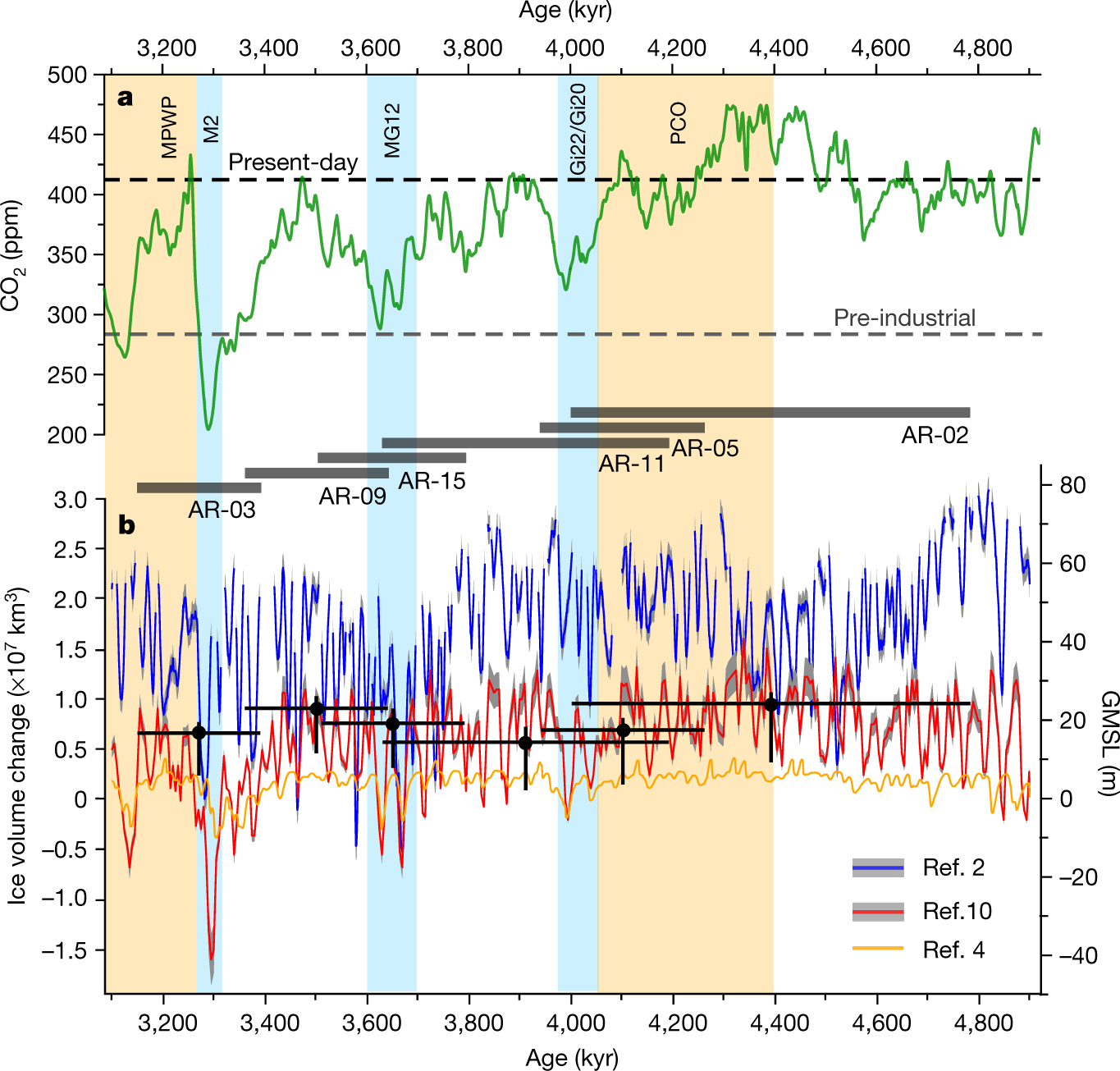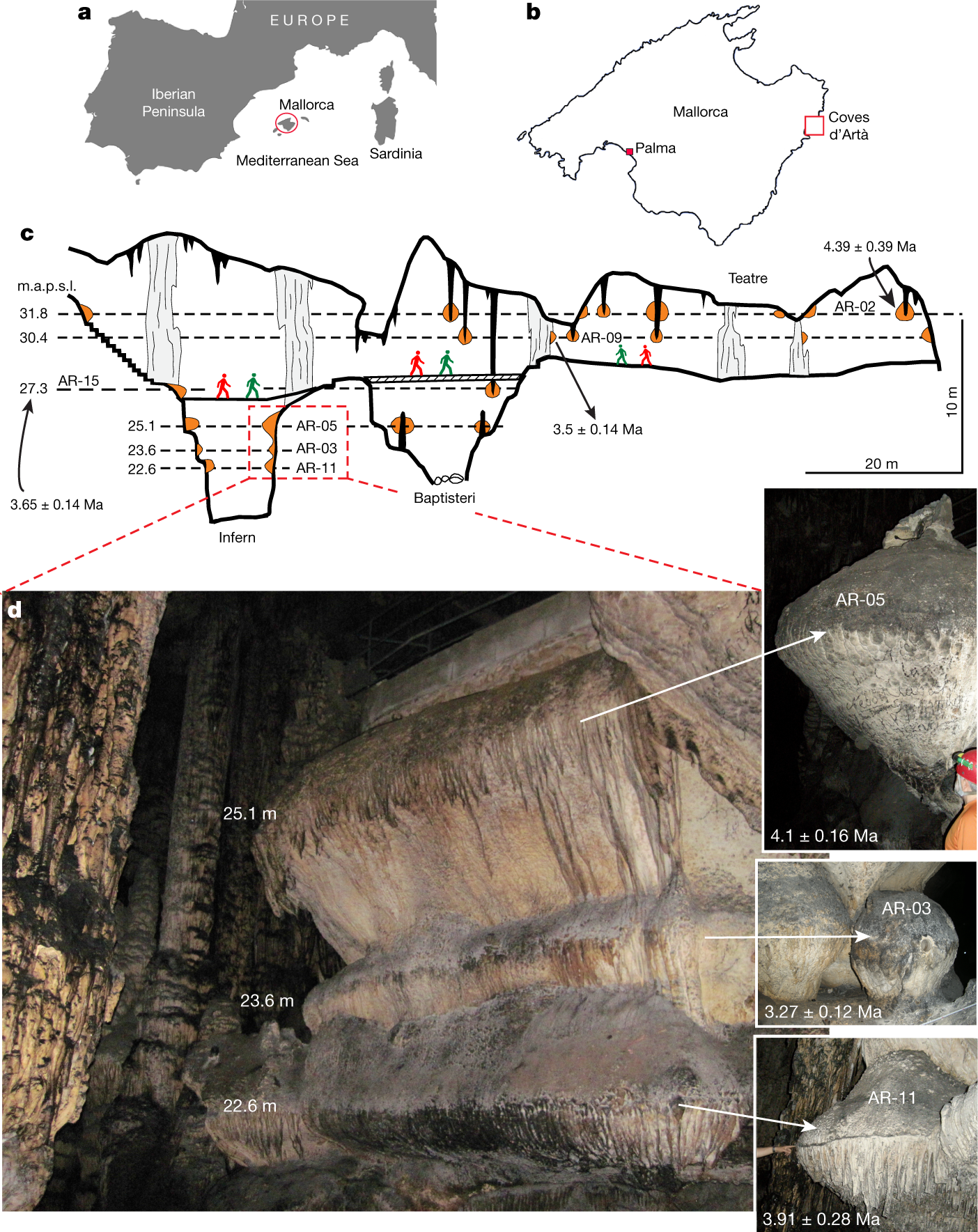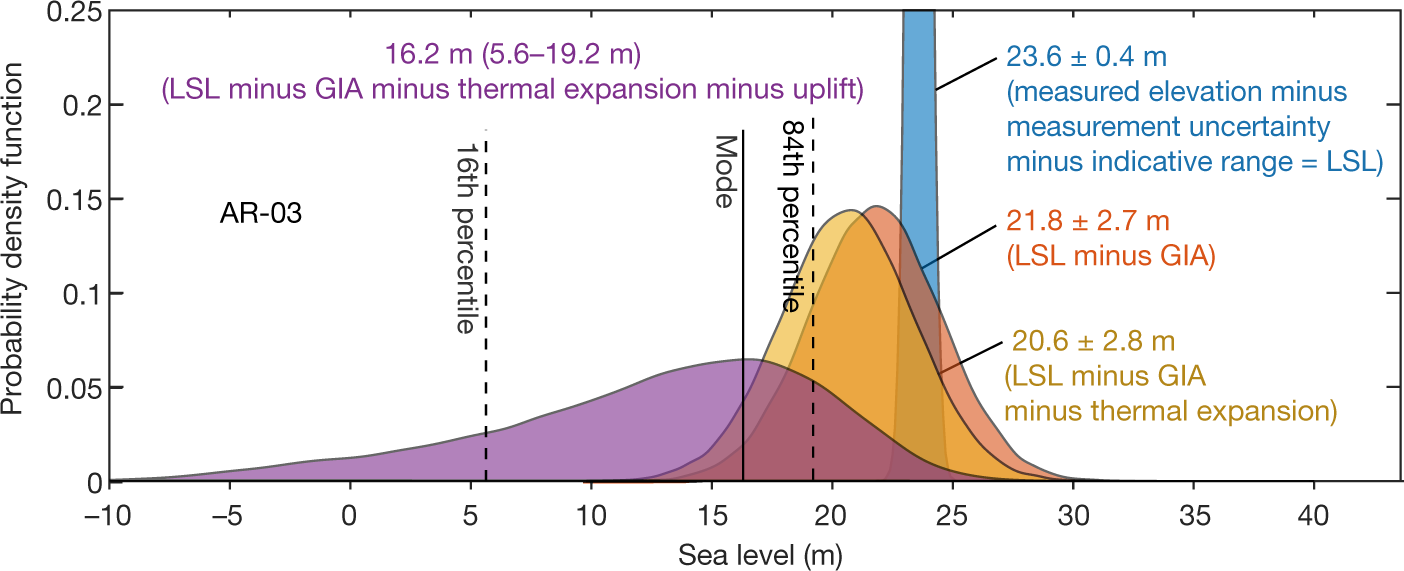Constraints on global mean sea level during Pliocene warmth: Sea level was 16-17 meters higher.
The paper I'll discuss is this one: Constraints on global mean sea level during Pliocene warmth (Onac, et al, Nature 574, 233–236 (2019)).
Currently, carbon dioxide accumulations are the highest recorded ever (although the record extends only to the mid 20th century), about 2.4 ppm per year and rising. We are currently reaching (or have reached) the annual minimum that comes every September. (It may end up being in October this year as the Northern Hemisphere's summer is extending with climate change.) The weekly low for this year was recorded at the Mauna Loa Carbon Dioxide Observatory for the week ending September 9, 2019, a reading of 407.96 ppm. The high for this year was recorded during the week ending May 12, 2019, when the reading was 415.39 ppm, the highest value ever recorded at Mauna Loa.
At 2.4 ppm per year, our current rising rate of increase, we should see 450 ppm in about 15 years, "by 2035" in the kind of language Greenpeace has been using for the last 50 years to describe when we will all live in a "renewable energy" nirvana powered solely be wind, solar, and all be driving electric cars, although in the old days, when I was a kid, that renewable energy nirvana was supposed to arrive "by 2000."
It didn't, but who's counting? We should do things on a faith basis, no, and only read Greenpeace "studies," because they always make you feel warm and fuzzy.
Warm, definitely. It's getting very hot these days. Fuzzy? I don't know. How does "fuzzy" feel?
The reason that this 450 number sticks in my mind, other than the 350 number about which Bill McKibben likes to talk, is the cited paper refers to a period, the Pliocene, which was relatively recent in geological history when carbon dioxide briefly was above 450 ppm. Let me jump the gun a little and post a figure from the paper before excerpting any text. Here it is, figure 3:

The caption:
a, Model-based CO2 reconstruction21 and relevant warm (orange bands) and cold (blue bands) climatic periods. b, Inferred GMSL and ice volume from Mallorcan POS are shown as black markers (age uncertainties are 2?; the GMSL of the marker corresponds to the mode; uncertainties are 16th and 84th percentiles). The sample code for each POS is indicated on the grey band between panels. Coloured curves show three different GMSL reconstructions (uncertainties on GMSL curves are 1? ). See Methods for the derivation of the GMSL curves. PCO, Pliocene Climatic Optimum.
Some text from the abstract, which should be open sourced:
Reconstructing the evolution of sea level during past warmer epochs such as the Pliocene provides insight into the response of sea level and ice sheets to prolonged warming1. Although estimates of the global mean sea level (GMSL) during this time do exist, they vary by several tens of metres2,3,4, hindering the assessment of past and future ice-sheet stability. Here we show that during the mid-Piacenzian Warm Period, which was on average two to three degrees Celsius warmer than the pre-industrial period5, the GMSL was about 16.2 metres higher than today owing to global ice-volume changes, and around 17.4 metres when thermal expansion of the oceans is included. During the even warmer Pliocene Climatic Optimum (about four degrees Celsius warmer than pre-industrial levels)6, our results show that the GMSL was 23.5 metres above the present level, with an additional 1.6 metres from thermal expansion. We provide six GMSL data points, ranging from 4.39 to 3.27 million years ago, that are based on phreatic overgrowths on speleothems from the western Mediterranean (Mallorca, Spain). This record is unique owing to its clear relationship to sea level, its reliable U–Pb ages and its long timespan, which allows us to quantify uncertainties on potential uplift.
From the paper's introduction:
Accurate predictions of future sea-level change hinge on our understanding of how ice sheets respond to changes in global temperature. To understand ice-sheet stability under prolonged warming (such as if the current level of temperature increase continues), we can use reconstructed sea level during past periods when Earth’s climate was warmer than today1. The Pliocene epoch (5.33 to 2.58 million years ago, Ma) was the most recent extended global warm period immediately preceding the inception of the high-magnitude glacial/interglacial variations of the Pleistocene8. The mid-Piacenzian Warm Period (MPWP), an interval during the Late Pliocene (3.264 to 3.025 Ma), has been used as an analogue for future anthropogenic warming since atmospheric CO2 conditions were comparable to present-day values (~400 ppm)9 and estimated global mean temperatures were elevated by 2–3?°C relative to the pre-industrial period5.
Oxygen isotope ratios from benthic foraminifera10 paired with deep ocean temperature estimates have been used to approximate ice-volume-equivalent GMSL changes over the Pliocene11,12. While invaluable, these approaches are limited by uncertainties in the methodology and a number of factors (for example, post-burial diagenesis, long-term changes in seawater chemistry and salinity) that are poorly constrained and may bias the sea-level estimates3. Field mapping of palaeoshorelines has been a complementary approach...
A few other means of estimating sea level height are given. The authors however choose a new approach:
Here we present Pliocene sea-level data from Coves d’Artà in the western Mediterranean (Mallorca, Spain; Fig. 1a, b) that are based on U–Pb absolute-dated phreatic overgrowths on speleothems (POS). POS offer several important benefits over other Pliocene sea-level indicators since they store all information needed for a meaningful sea-level index point: (1) precise spatial geographic positioning, (2) accurate elevation, (3) clear indicative meaning (their growth covers the full tidal range, thus having an explicit relation to past sea level; see Methods), and (4) an absolute age (since the crystalline aragonite/calcite often contains suitable uranium concentrations for robust dating19). POS are primarily precipitated in caves, at the water/air interface as CO2 degasses from brackish cave pools. The water table in these caves is, and was in the past, coincident with sea level, given that the caves are at most 300 m away from the coast and the karst topography is low. Six POS levels have been identified at elevations from 22.6 to 31.8 m.a.p.s.l. (uncertainties in the elevation measurement and the indicative range are less than 1 m; Fig. 1c, Table 1)...
"Phereatic overgrowths on speleotherms" refer to deposits that form on stalactites and stalagmites when they go under water.
Table 1:

Some other pictures in the paper:

The caption:

The caption:
Contribution of different corrections (GIA, uplift and thermal expansion) and uncertainties when inferring the GMSL from the POS elevation (this breakdown is for AR-03; see Extended Data Fig. 8 for all POS). Probability density function of the POS elevation with consecutive corrections for the measurement and indicative range leading to an estimate of local sea level (LSL; blue), GIA (orange), long-term uplift (purple curve) and thermal expansion (yellow). We choose the mode (solid black line) as the best estimate and the 16th and 84th percentiles (dashed black line) as the uncertainty range.
Figure 3 was produced here earlier.
An excerpt of the conclusion:
Given that global average temperatures during the MPWP were 2–3?°C higher than pre-industrial values5 and CO2 concentration was 400 ppm (ref. 9), our results indicate that an ice volume equivalent to a GMSL change of 16.2 m.a.p.s.l. (5.6–19.2 m.a.p.s.l.) may eventually melt (over hundreds to thousands of years) if future temperatures stabilize at that level of warming. Given present-day melt patterns26, this sea-level rise is likely to be sourced from a collapse of both Greenland and the West Antarctic ice sheets. A temperature increase to 4?°C above pre-industrial levels is comparable to conditions during the Pliocene Climatic Optimum6 with a GMSL estimate of 23.5 m.a.p.s.l. (9.0–26.7 m.a.p.s.l.), which indicates further ice melt if temperatures stabilize at this higher level. Thermal expansion is expected to cause additional sea-level rise in these scenarios.
"m.a.p.s.l" is an unnecessary abbreviation of "meters above present sea level."
Don't worry. Be happy. It's not your problem. You'll be dead "by 2100" just like the people who bet the planet on so called "renewable energy," but happily will be dead when future generations will almost certainly not be able to achieve, because we have insisted blithely, that it will be
easy for them to do what we could not do ourselves.
Most likely, the reality is that future generations, much as was the case for all generations before the 19th century will actually experience living by "renewable energy" the way those generations did: Then, as in the future
I predict - may I be proved wrong - even more so than today, the bulk of humanity lived short, miserable lives of dire poverty.
History will not forgive us, nor should it.
I hope you enjoy the upcoming weekend.




![]()